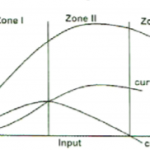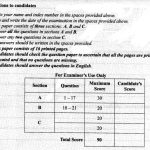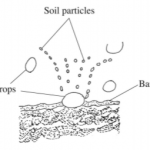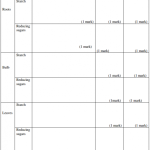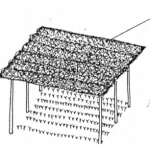KNEC KCSE Past Papers 2016 Agriculture Paper 1 (443/1)
Kenya certificate of Secondary Education
2016 Agriculture Paper 1
SECTION A
(30 marks) Answer all the questions in this section in the spaces provided.
1. List four factors that would determine the stage at which a crop is harvested. (2 marks)
2. State two ways in which crop rotation controls weeds. (1 mark)
3. Give two factors which characterize small scale farming. (1 mark)
4. Give two examples for each of the following categories of water pipes.
(a) Metal pipes (I mark)
(b) Hose pipes (1 mark)
5. State the information included in a sales receipt when a farmer is selling eggs. (2½ marks)
6. State four characteristics of a good vegetable seedling. (2 marks)
7. Name three forms of horticulture practiced in Kenya. (1 ½ marks)
8. State two mechanical methods of separate line soil particles according to size, during soil analysis. ( I mark)
9. List four disadvantages of mono cropping in crop production. (2 marks)
10. State two reasons for practicing agro forestry on a
(a) river-bank (1 mark)
(b) steep slope (1 mark)
11. Give three reasons for growing crops under optimun temperature conditions. (1 ½ marks)
12. State four reasons for treating water for use on a farm. (2 marks)
13. Outline two w-ays of controlling damping off disease on vegetable seedlings in a nursery. (1 mark)
14. State four factors that affect the quality of farm-yard manure. (2 marks)
15. Distinguish between grading and standardization in agricultural marketing. (2 marks)
16. Give four disadvantages of broadcasting as a method of planting. (2 marks)
17. State three practices which encourage soil erosion. ( I ½ marks) 18. Name two types of noncompetitive markets. (1 mark)
SECTION B (20 marks)
Answer all questions in this section in the spaces provided 19.
The diagram below shows crop establishment using a certain method of planting.
Study it carefully and then answer the questions that follow.

(a) Name the method of planting used for the crop. (1 mark)
(b) State two advantages of the planting method used for the crop. (2 marks)
(c) State two factors that determine the depth of planting,. (2 marks)
20. The diagram below illustrates a feature observed after digging the soil several meters deep. Study the diagram carefully and answer the questions that follow.
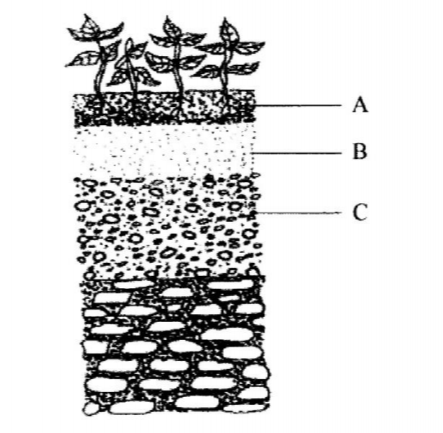
(a) Identify the feature that the diagram above represents in the study of soil. (I mark)
(b) Name the parts of the diagram labeled A, B and C. (1½ marks)
A
B
C
(c) State two ways in which the knowledge of the above feature would be of benefit to a farmer. (2 marks)
21. Below is a graphical representation of a law in agricultural economics. Study the graph carefully and answer the questions that follow:
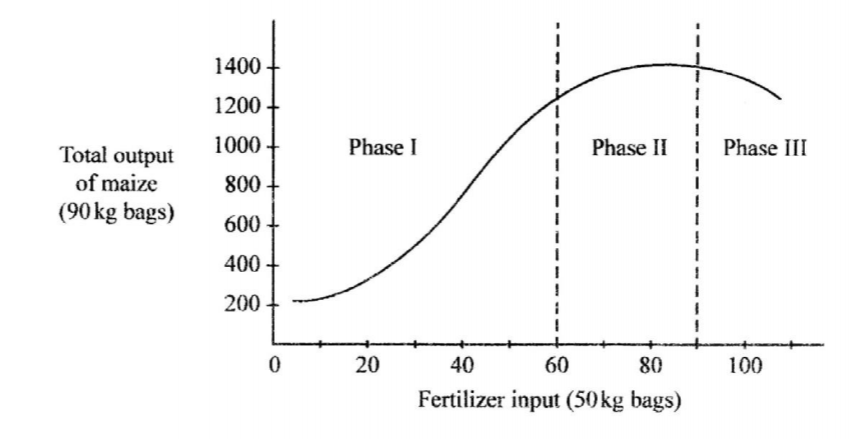
(a) Identify the law illustrated by the graph. (1/2 mark)
(b) Explain how each additional unit of fertilizer input relates to the total output of maize in phases 11 and HI. Phase II (1 mark) Phase III (1 mark)
(c) State the importance of the law identified in (i) above to the maize farmer. (1 mark)
22. The following is a list of plant nutrients; copper, calcium, nitrogen, molybdenum, zinc, phosphorous, carbon, sulphur, iron and magnesium. Which of the above plant nutrients are: (a) Macro-nutrients ( I mark)
(b) Micro-nutrients (1 mark)
(c) Fertilizer elements (1 mark)
(d) Liming elements (1 mark)
23. The table below shows pH value of different soil samples. Study it and answer the questions that follow.
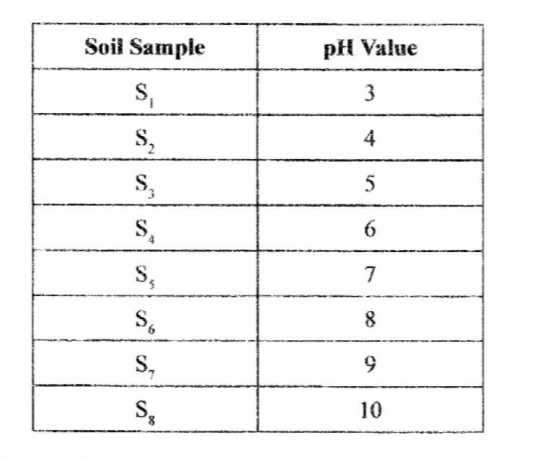
(a) Which soil sample has the highest acidity? (1 mark)
(b) State two ways in which the pH value of sample S, can be lowered. (1 mark)
(c) Which of the above soil samples is suitable for growing tea? ( I mark)
SECTION C (40 marks)
Answer am two questions from this section in the space provided after question 26.
24. (a) Outline the information contained in a purchase order. (5 marks)
(b) Describe the harvesting of tea. (6 marks)
(c) Explain the importance of irrigation in crop production. (5 marks)
(d) Describe the role of magnesium in crop production. (4 marks)
25.(a) Describe the effects of pests on maize in the field. (6 marks)
(b) (i) Describe the procedure of harvesting pyrethrum. (4 marks)
(ii) Explain the precautions that should be observed during the harvesting of pyrethrum. (3 marks)
(c) Describe the cultural methods of controlling soil erosion. (7 marks)
26. (a) Explain eight cultural methods of soil and water conservation. (8 marks)
(b) Explain four ways in which: (i) HIV/AIDS limits agricultural production. (4 marks)
(ii) Government policy improves agricultural production. (4 marks)
(iii) I .ow level of education and technology influence agriculture. (4 marks)
Questions and Answers
2016 Agriculture Paper 1
No. 1.List four factors that would determine the stage at which a crop is harvested. (2 marks)
❖ Intended use of the crop
❖ Chemical concentration of the produce/ stage of maturity/ change in color
❖ Prevailing weather conditions
❖ Market demand for the produce/ market price
No.2.State two ways in which crop rotation controls weeds. (1 mark)
❖ Crops associated with specific weeds are alternated with crops of different families to remove the appropriate host and break the life cycle of weeds.
❖ Alternating with cover crops smoothers the weeds
No.3.Give two factors which characterize small scale farming. (1 mark)
❖ Small size of land.
❖ Limited capital.
❖ Simple/ limited tools/ or implement.
❖ Less labor required.
❖ Maximizes labor available.
No.4.Give two examples for each of the following categories of water pipes.
(a) Metal pipes (1 mark)
❖ Galvanized iron popes/ steel pipes
❖ Aluminum pipes
(b) Hose pipes (1 mark)
❖ Rubber pipes
❖ Plastic Hose pipes/ Pvc pipes (Poly viney chloride pipes)
No.5. State the information included in a sales receipt when a farmer is selling eggs.
❖ Date;
❖ Quantity of eggs;
❖ Price;
❖ Amount/ total;
❖ Buyer’s name;
❖ Name of the farm/farmer;
❖ Signature;
❖ Serial number;
❖ Mode of payment (cheque/ cash/ in kind)
No.6.State four characteristics of a good vegetable seedling. (2 marks)
❖ Free from disease/pest/healthy;
❖ Vigorous growing;
❖ Free from physical deformities;
❖ High yielding;
❖ Correct stage of growth/height 10 – 15 tall/ 4 – 6 true leaves.
No.7.Name three forms of horticulture practiced in Kenya.
❖ loriculture
❖ pomoculture/ pomology
❖ Olericulture
No.8. State two mechanical methods of separating soil particles according to size, during soil analysis. 1 mark)
❖ Using a sieve / sieve analysis.
❖ Sedimentation method
No.9. List four disadvantages of mono cropping in crop production. (2 marks)
❖ High risk of total less incase-of crop failure.
❖ Under utilization of some soil nutrients
❖ Build up of crop pests and diseases/ weeds.
❖ Only specific mineral nutrients are absorbed / exhaustion of certain nutrients from the soil results in soil erosion in crops with poor ground coverage.
❖ Faster spread of pests and diseases.
No.10.State two reasons for practicing agro forestry on a
(a) river-bank (1 mark)
❖ Stabilize river bank/ control river bank erosion;
❖ Slow down speed of surface runoff;
❖ Trap soil/ debris in surface runoff;
❖ Reduces risk of flooding;
(b) steep slope (1 mark)
❖ Reduce speed of runoff;
❖ Trap soil in erosive water;
❖ Tree roots bind and stabilize the soil/ maintains soil structure;
No.11. Give three reasons for growing crops under optimum temperature conditions.
❖ Enhance seed germination/ emergence;
❖ Promote soil microbial activities;
❖ Improve quality of crop products;
❖ Enhance vigorous growth and development;
or ❖ Enhance high yields.
No.12 .State four reasons for treating water for use on a farm. (2 marks)
❖ Remove chemical impurities/ softening of water
❖ Kill disease causing organisms/ kill germs/ pathogens
❖ Remove bad smells and taste
❖ Remove impurities of solid particles
No.13. Outline two ways of controlling damping off disease on vegetable seedlings in a nursery.(1 mark)
❖ Reduce/ remove shade
❖ Thinning to reduce overcrowding
❖Reducing amount and frequency of watering
❖ Spaying with copper fungicides /appropriate fungicides
No.14.State four factors that affect the quality of farm-yard manure. (2 marks)
❖ Types of animal used
❖ Type of feed eaten
❖ Types of litter used
❖ Age of farmyard manure
❖ Method of storage
❖ Species of animals from which the manure is obtained
No.15.Distinguish between grading and standardization in agricultural marketing. (2 marks)
Grading – is the sorting of the produce into different lots each with the same characteristics market quality while
Standardization– is the establishment of uniformity in the quality and quantity of the product.
No.16 ‘Give four disadvantages of broadcasting as a method of planting. (2 marks)
❖ More seeds are used / seed wastage;
❖ Lack of uniformity in land coverage / uneven land coverage;
❖ Uneven planting depth / uneven germination / uneven growth;
❖ Difficult to carry out subsequent operations such as weeding, spraying, harvesting;
❖ Competition for nutrients, water, light leading to poor performance of the crop;
❖ Difficult to establish correct plant population;
❖ Difficult to Mechanise.
No.17.State three practices which encourage soil erosion.
❖ Over -cultivation, overstocking/ overgrazing.
❖ Deforestation/ planting annual crops on steep slopes.
❖ Burning of the vegetation.
❖ Ploughing up and down the slope.
No.18. Name two types of non-competitive markets. (1 mark)
❖ Monopoly/ monopolistic markets
❖ Oligopoly/ Oligopolistic markets
❖ Monopsony/ monopsonistic markets.
No.19 .The diagram below shows crop establishment using a certain method of planting
The diagram below shows crop establishment using a certain method of planting. Study it carefully and then answer the questions that follow.
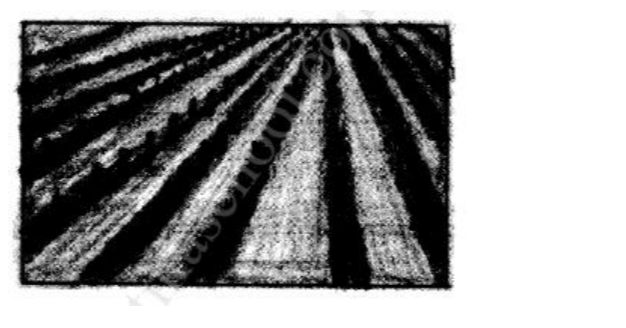
(a) Name the method of planting used for the crop. (1 mark)
❖ Row planting
(b) State two advantages of the planting method used for the crop. (2 marks)
❖ Operations can be mechanized
❖ Easy to establish plant population
❖ Use less planting materials compared to broadcasting
❖ Eeasy to carry out cultural practices
(c) Explain two factors that determine the depth of planting. (2 marks)
❖ Soil type:
light soil requires deeper /greater depth
❖ Soil moisture content: wet soils requires shallow depth;
❖ Size of the seed: large seeds require greater depth
❖ Types of germination: epigeal germination requires shallow depth
No.20.The diagram below illustrates a feature observed after digging the soil several meters deep. Study the diagram carefully and answer the questions that follow
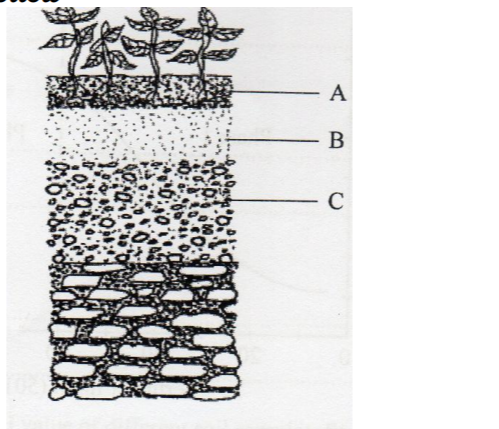
(a) Identify the feature that the diagram above represents in the study of soil. (1 mark)
❖ soil profile
(b) Name the parts of the diagram labeled A, B and C.
A. ❖ Top soil
B. ❖ Sub soil
C. ❖ Substratum/ weathered rocks
(c) State two ways in which the knowledge of the above feature would be of benefit to a farmer. (2 marks)
(b) Name the parts of the diagram labeled A, B and C.
A. ❖ Top soil
B. ❖ Sub soil
C. ❖ Substratum/ weathered rocks
(c) State two ways in which the knowledge of the above feature would be of benefit to a farmer. (2 marks)
❖ Helps the farmer to choose appropriate crop to grow
❖ Helps to determine depth of ploughing
❖ Helps the farmer to determine the kind of foundations for farm structure
❖ Helps the farmer to choose appropriate crop to grow
❖ Helps to determine depth of ploughing
❖ Helps the farmer to determine the kind of foundations for farm structure
No.21.Below is a graphical representation of a law in agricultural economics. Study the graph carefully and answer the questions that follow:
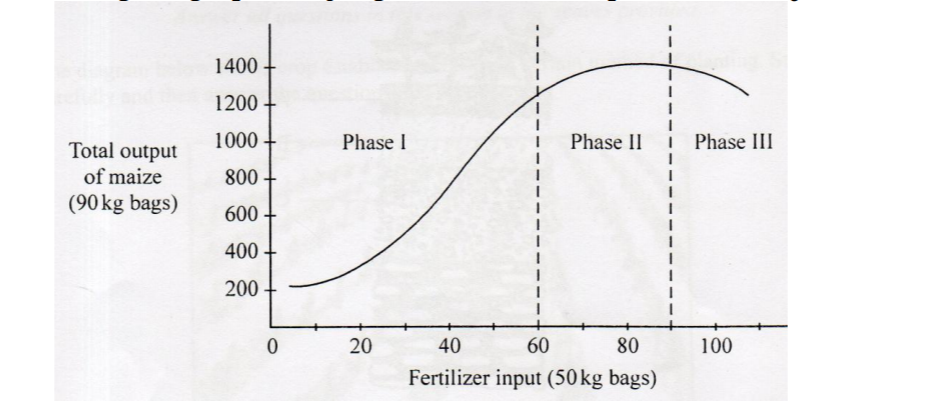
(a) Identify the law illustrated by the graph.
❖ Phase II
❖ Each additional unit of fertilizer input leads to a lower increase in total output of maize than the previous unit of fertilizer O.W.T.T.F.
(b) Explain how each additional unit of fertilizer input relates to the total output of maize in phases II and III. Phase III (1 mark)
❖ Each additional unit of fertilizer input leads to a decrease in total ouput of maize.
(c) State the importance of the law identified in (i) above to the maize farmer.
(1 mark).
❖ Helps the farmer to identity the level of optimum fertilizer application in the production of maize. / To determine the highest level of maize and put O.W.T.T.E
No.22.The following is a list of plant nutrients; copper, calcium, nitrogen, molybdenum, zinc, phosphorous, carbon, sulphur, iron and magnesium. Which of the above plant nutrients are: (a)Macro-nutrients (1 mark)
❖ Calcium;
❖ Nitrogen;
❖ Phosphorous;
❖ Carbon;
❖ Sulphur;
❖ Magnesium.
(b)Micro-nutrients(1 mark)
❖ Copper;
❖ Molybdenum;
❖ Zinc;
❖ Iron.
(c)Fertilizer elements(1 mark)
❖ Nitrogen, Phosphrous & Potassium
(d)Liming elements(1 mark)
❖ Calcium; Magnesium and Sulphur
No.23.The table below shows pH value of different soil samples. Study it and answer the questions that follow.
Soil Sample pH value
S1 3
S2 4
S3 5
S4 6
S5 7
S6 8
S7 9
S8 10
(a) Which soil sample has the highest acidity?
❖ Sample Si
(b) State two ways in which the pH value of samples S8 can be lowered. (1 mark)
❖ Application of acidic fertilizers: Accept S/ A; ASN; DAP; MA
(c) Which of the above soil samples is suitable for growing tea?
• S2
• S3
• S4
No.24a. Outline the information contained in a purchase order. (5 marks)
❖ Qualities of goods
❖ Type of goods required
❖ Date of order
❖ Date within which the ordered goods should be delivered
❖ Person who orders the goods
❖ Person who authorized the order
❖ Purchase order serial
❖ Total cost amount/ cost involved
❖ Cost of the good cost of each good
No.24.(b) Describe the harvesting of tea. (6 marks)
❖ Leaves are picked selectively for the highest quality
❖ Pluck top two leaves and the bud
❖ Use a plucking stick to maintain the plucking table
❖ Pluck at 5 – 7 days intervals in rains and 10 – 14day in dry periods/ cold period.
❖ Put plucked tea in woven baskets to facilitate air circulation/ prevent fermentation
❖ Do not compress the leaves in these baskets to prevent heating up/ brownir
❖ Put plucked tea in cool and shaded place • Deliver to the factory on the same day
No.24c’Explain the importance of irrigation in crop production.(5 marks)
❖ Irrigation increases crop yields and ensure a steady supply of food throughout the year
❖ Maximizes the utilization of resources e.g. in places where the soil is fertile but the water / rain is inadequate
❖ Important for the reclamation of arid and semi-arid land.
❖ Provides a regular reliable and adequate supply of water in areas with little rainfall.
❖ Source of employment in areas where it is used extensively.
❖ Promotes crop production for the export market and therefore contributes to a country’s revenue
❖ Allows production of paddy rice
❖ Allows growing of crops in green houses
❖ Facilitates irrigation in crop production
❖ Controls pests
No.24d. Describe the role of magnesium in crop production. (4 marks)
❖ Important in chlorophyll formation
❖ Promotes the formation of fats and oils in crops eg soya beans, sunflower, ground nuts.
❖ Aids in the absorption and translocation of phosphorous
❖ Enhances the nitrogen fixing power of the legumes
❖ Activates the synthesis and translocation of carbohydrates and proteins in plants.
❖ Activates enzymes in crops.
No.25a.Describe the effects of pests on maize in the field. (6 marks)
❖ Some pests transmit crop diseases e.g. leaf hoppers.
❖ Some pests eat the growing points causing retarded growth e.g. livestock, stalk, borers, wild animals.
❖ Some pests attack the fruits/lowering their quality / quantity e.g. birds, bollwarms.
❖ Some pests eat the foliage/leaves reducing the surface area for photosynthesis.
❖ Some pests damage crop roots/ causing wilting and death to the plants e.g. termites, rodents, wild pigs, stalk borer,
❖ Some pests pierce and suck sap from the plant depriving the plant of food e.g. aphids.
❖ Some pests injure and cause wounds on the plant exposing it to secondary infections.
No.25.(b) (i)Describe the procedure of harvesting pyrethrum. (4 marks)
❖ Pick flowers selectively
❖ Pick flowers that have horizontal petals (ray florets) with 2-3 rows of disc florets open.
❖ Use for fingers and the thumb
❖ Pick by twisting the heads so that no stem is left attached.
❖ Put the picked flowers in woven basket.
(b) (ii)Explain the precautions that should be observed during the harvesting of pyrethrum. (3 marks)
❖ Precautions observed during harvesting of pyrethrum
❖ Pricking starts 3-4 months to maintain quality
❖ Picked flowers are put in woven baskets to allow ventilation and avoid fermentation of flowers.
❖ Wet flowers should not be picked because they heat up and ferment
❖ Picked flowers should not be compacted to avoid heating up and fermenting.
❖ A suitable picking intervals/ 14-21 days is maintained to avoid harvesting overblown flowers.
❖ Break the flower stalk to maintain quality
No.25c.Describe the cultural methods of controlling soil erosion. (7 marks)
❖ Contour farming: Cultivation and planting done across the slope helps in holding water thereby increasing infiltration and reducing runoff.
❖ Mulching: covers the soil thereby reducing splash erosion/ reduces speed of runoff.
❖ Strip cropping alternating strips of crops that give good soil cover with those that give little soil cover controls movement of soil particles thereby helping in control of erosion.
❖ Vegetated waterways: vegetation in waterways slows down run off/ traps eroded soil particles Hereby preventing further erosion.
❖ Afforestation/ reafforestation trees, protect soil from splash erosion by atomising – raindrops/ encourage water infiltration/ protect soil from winds, which could detach and remove soil particles,
❖ Inter-cropping crops which do not cover soil with crops that have good ground cover.
❖ Minimum tillage so as to maintain good soil structure/ have a seed bed with rough surface such that .soil particles are not easily detached encourage water percolation
❖ Cover cropping: establishing a crop that spreads over the surface of soil thereby protecting soil from effects of raindrops.
❖ Grass strips filter strips are left between cultivated/ cropped strips of land to reduced
No.26a.(a)Explain eight cultural methods of soil and water conservation (8 marks)
Grass/ Filter strips:- reduce speed of flowing water/ filter soil; Cover cropping:prevents surface flow/ reduces impact of rain drops/ prevents evapor ation/ volatilization; Contour farming:-creates ridges of soil which hold up water/ reduce speed of run-off; Mulching:- reduces impact of rain drops/ prevents evaporation/ surface run-off;
❖ Rotational grazing:– allows grass to recover for soil and water conservation;
❖ Crop rotation: maintain soil cover for protection against erosion/ improves soil str ucture thus increasing infiltration;
❖ Inter cropping:– provides adequate cover on the soil;
❖ Strip cropping:
– the different strips reduce speed of run-off/filter soil;
❖ Grassed/ vegetated waterways:– slow the speed of water/ trap eroded soil;
❖ Afforestation/Re-afforestation; Act as water catchments/ stabilizes soil/ canopy intercepts raindrops/ wind;
❖ Agroforestry:stabilises soil/ canopy intercepts raindrops/ act as water catchmen/ wind;
❖ Use of manures/fertilizers; Promotes vegetative growth which covers soil again evaporation and erosion;
❖ Correct spacing of crops; Ensure adequate soil cover.
(b) Explain four ways in which: (i) HIV/AIDS limits agricultural production(4 marks)
❖ Shortage of labour;
❖ Lack of motivation to invest in agriculture
❖ Increased cost of living leading to low investment in agriculture/ lack of resources for Agricultural production.;
❖ Government and NGOs are spending a lot of time and resources controlling the disease instead of investment in agriculture.
❖ Lack of market for agricultual produce (ii)Government policy improves agricultural production (4 marks)
❖ Establishment of national food security policy to supply free farm input to farmers to improve production;
❖ Facilitate soil conservation;
❖ Imposes laws to regulate quality of agriculture products;
❖ Imposes laws to regulate production and sale of agricultural produce to Ensure sustainability;
❖ Imposes high taxes on imported agricultural products;
❖ Providing subsidies on agricultural inputs, e.g. fertilizers;
❖ Establishment of government agencies to supply inputs and market Agricultural products;
❖ Construction of bulky handling and storage facilities for agricultural
❖ products;
❖ Funding research into new and improved agricultural production
❖ technologies;
❖ Ensures control of parasites/ diseases/ weeds is done effectively;
❖ Provision of extension services/ education.
(iii) Low level of education and technology influences agriculture. (4 marks)
❖ Improper timing of routine practices;
❖ Lack of agricultural skills
❖ Low production of low quality ;
❖ Inappropriate decision – making e.g. disease observation and control;
❖ Delayed adoption of new and improved production technologies.
❖ Lack of knowledge to apply / types and / of inputs;
❖ Inability to collect market information.

